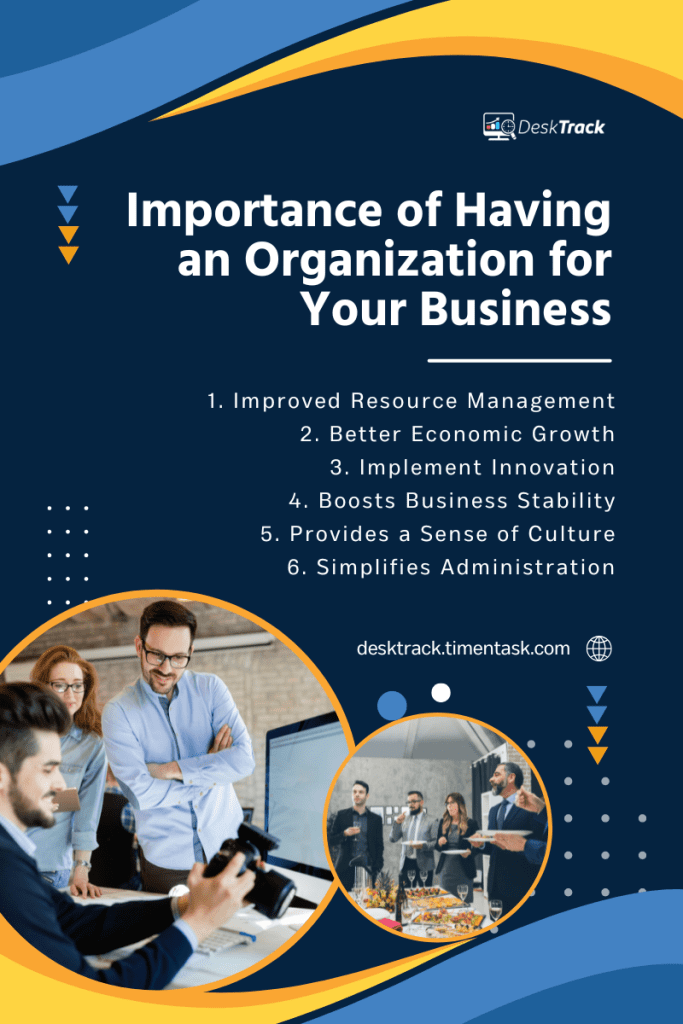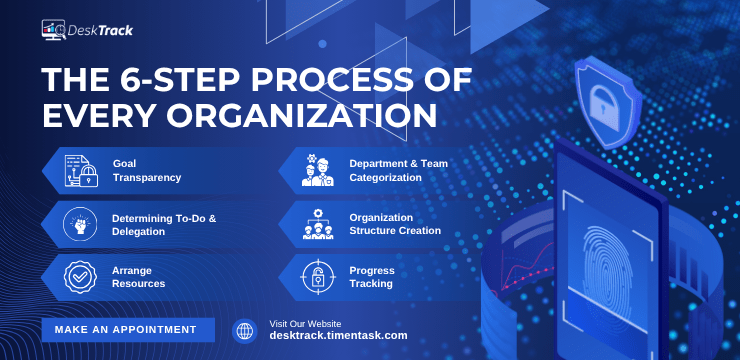
We often use the terms organization and business interchangeably. However, they are different. Likewise, a business can’t survive without an organization, nor can an organization do well without a business. They need each other. Nonetheless, which one’s which? Now, you already know what a business is. However:
What is an Organization?
Simply put, when you bring together a group of things or people, it’s called an organization. In business terms, it’s always the people, technically known as human resources. Also, the approach is structured, and the people work towards achieving common objectives. Primarily, the country or state’s tax laws bind and register these structures.
Read Also: Top 10 Best Workforce Planning Software for 2025
Types of Organizations

Depending on the type of your business, how it’s registered, the hierarchy of the structure, and other factors, there are a few categories of organizations. So, you will surely find yours in this list.
1. For-Profit
These business infrastructures are here to make money. For-profit means to get profit or, in layman’s terms, income. It can be stock market trading or privately owned. For instance, a partnership.
2. Non-Profit
These organizations are here to help with a cause through individual or community efforts. The structure, also known as an NGO, will promote social awareness and ask people to join them either voluntarily or via donations. For example, charities.
3. Government
The government creates and supports these arrangements to provide public services. However, their reach is limited to state, local, or national levels. One example can be police departments.
4. International Businesses
The importance of organization is significant in these types of businesses. The business will have a headquarter in one country and various branches accustomed to local cultures spread around the world. This is also a type of for-profit enterprise. For example, a restaurant chain.
5. International
This non-profit infrastructure works towards bringing all countries together to make what’s globally wrong right worldwide. They handle global problems, such as peace, health, and trade. For example, the United Nations, or the UN, is a popular international organization, working tirelessly towards world peace.
6. Informal
These organizations have no structure but are community-based. However, a group with common goals and interests forms them. For instance, hobby clubs.
Importance of Having an Organization for Your Business

As we mentioned before, an organization’s meaning comes down to arrangement. Whether you align work, people, infrastructure, or anything together, it is an organization. However, there are more benefits to it than that.
1. Improved Resource Management
When everything is organized in a system, resource utilization becomes better. Simply put, you realize your limitations when you have a structure, so you start using your people, tools, and time more responsibly. You know what we mean. Right?
2. Better Economic Growth
As we all know, business organizations contribute a lot to society with their services and products. They provide employment, pay their taxes, and help a lot in national and international economic expansion.
3. Implement Innovation
Business enterprises thrive through research and development. They bring technological advancements and innovation to their products and services. Gradually, adapting to public demands and market requirements, they implement innovation with the idea of changing the world.
4. Boosts Business Stability
When your people, time, and tools are aligned and properly arranged, everything else falls into place. This improves business stability as you have a proper idea of how everything is happening in your Fortune 500.
5. Provides a Sense of Culture
Another reason behind the importance of organization is that it provides your business with a sense of culture. That’s because of the respect for the values and beliefs of the people within the structure, which is the main thing. Plus, enterprises also respect the beliefs and values of their customers, which spreads this sense of culture.
6. Simplifies Administration
Having an organizational structure simplifies administration as it makes daily operations and strategic planning much easier. Again, this is because people, time, and tools are arranged and aligned.
Key Characteristics of an Organization
Make your workday more productive
Time tracking and work management can help you reach your goals
faster.
Like everything else, having a structure, an organization, also has its own characteristics, or you can say distinct qualities or features to be exact. Here are 8 that you will find in every enterprise.
1. Transparent Objectives & Purpose
Firstly, every business arrangement has clear goals and a purpose. Without them, it will not move forward or run stably. Setting transparent objectives and a purpose will help your people better understand what to do and, more importantly, why they are doing it. This adds more clarity to how things work in your business.
2. Innovation & Adaptability
Enterprises innovate and adapt. That’s the core of every business. These arrangements innovate their products and services through technological advancements. Plus, every organization does its best to adapt to the market trends, which creates competition.
3. Labor Division
Employee categorization is very important for every business arrangement. You don’t want to pay a manager’s salary to an office boy. Do you? Besides, it’s also essential for labor law compliance, accurate payroll, and audit.
4. Specialization
We mean providing opportunities here. Organizational structures get the best out of their people’s skills by providing them with opportunities to grow in their respective fields. Another organization meaning here, can be that the business itself has a specialized niche. For instance, a cafe specializes in brewing different kinds of coffee and preparing delicious snacks.
5. Resource Management
As we mentioned before, having an organizational structure improves resource management. This is because you know which people will work on what tasks to bring you maximum productivity.
6. Cooperative Relationships
Every business organization is also a corporation. Just like there is a bond in families, there is also a relationship in corporations, which is known as a cooperative society. However, unlike families, this bond is only at a professional level. This is only so that people with different perspectives can keep their grudges aside and work together to achieve a common goal. Similarly, there are also cooperative bonds with clients.
7. Dynamic Processes
There are many internal and external processes going on in an organization at a time. These are dynamic and are like the fuel that keeps the engine running. For example, when developing a video game, the process will involve steps such as character design, sound and dialogue recording, testing, and programming actions.
8. Hierarchy
Every business arrangement has a hierarchy of people. The hierarchical structure also defines who has more authority, control, and rights. In layman’s terms, who can argue or talk back to whom. For example, A CEO can always scold managers. However, the managers can’t talk back. Otherwise, there is the threat of their contract being terminated. Hierarchy also decides the importance of tasks and delegation.
Different Structures of Organizations
Like everything else, an organization will also have an internal structure. This structure defines how things work, how tasks are delegated, the level of authority, and many other aspects.
1. Flat
This is a rarely seen organizational structure. As the name suggests, a flat infrastructure will only have a few tiers of management. As you may have already guessed, managers have a wider authority and a direct chain of command, as there is less to no middle management in existence here.
2. Functional
Yes, this is where you divide your employees across various departments. You will put each employee in a specific group according to their skills, roles, etc. There are multiple levels of hierarchy here, and every specific group will have a leader to implement authority and delegation.
3. Divisional
When you divide your organization into parallel sub-organizations, the structure is divisional. The divisions are in charge of specific products, services, geographic regions, a target demographic, or a group of people. Divisional structures are perfect for businesses operating around the world.
4. Matrix
It is one of the most complicated organizational structures on our list. That’s because it has a bigger chain of command. Ie, multiple lines of reporting managerial staff. All you have to understand here is that one employee will have several direct bosses. The rest is just technical jargon.
5. Team-Based
This is a combined organizational structure, which has the characteristics of a functional and a matrix organization. The importance of organization here is to ensure that people work the right way because there are also cross-functional teams involved now, managing which is complex.
6. Network
This one is self-explanatory. A network is a chain of interlinked organizations owned by the same founder, an integration of several functions spread across infrastructures, or each business can also be owned by different CEOs. Nonetheless, the organizational network has the advantage of a higher level of teamwork for creating products and services. For example, a business outsourcing logistics while keeping development processes in-house.
7. Hierarchical
This organization has 2 distinct characteristics. Firstly, the structure is pyramid-like. Secondly, the chain of command is vertical. For example, it goes from the CEO (top), down to entry-level employees with managerial staff in between.
Importance of Having a Well-Structured Organization
An arrangement, unless it’s well structured, will not do you any good. Here’s why having an infrastructure is important for your Fortune 500 enterprise.
- Improves teamwork and optimizes processes
- Increases the business’s managerial capabilities
- Establishes communication trends and channels for proper managerial oversight
- Adds to the advancements and diversifications of your business activities
- It eliminates duplicated functions, allowing you to achieve maximum output for the effort put in, ultimately streamlining your work.
Read Also: Top 10 Employee PTO Tracking Software for Businesses in 2025
The 6-Step Process of Every Organization

Regardless of the niche, industry, size, or specialization of the business, every organization will follow a 7-step process. Here’s how it works.
1. Goal Transparency
Firstly, every business must have clarity on what it wants to achieve. Otherwise, the employees won’t know what to do and why. This brings together the people to put in the maximum effort to fulfill common objectives.
2. Determining To-Do & Delegation
Once you have defined your goals, you will create a to-do list. You will end up with separate long lists of daily tasks and long-term objectives. Now, you need to work on deciding who will do what. Once that’s down, with a technique such as the Eisenhower matrix, the only thing left to do is assign the right users to the right tasks.
3. Arrange Resources
Your teams will need sufficient resources to provide you with the best quality results. These include tools and time. The person responsible must provide these resources to the workers to ensure that they achieve the goals as expected.
4. Department & Team Categorization
It is also crucial to correctly categorize your departments and teams for 2 things. Firstly, to get work done properly. For example, leave the coding part to the development teams. Secondly, it is also important for proper audit and labor law compliance.
5. Organization Structure Creation
Based on all your requirements and how you want to establish the chain of command and authority, you must also choose a proper organizational structure for yourself. For example, if your goal is to become an international business, you will go for a divisional organization.
6. Progress Tracking
Now, we are all set, and work has begun. Now, you need to ensure that everything goes smoothly and your teams are handling obstructions well. This is possible only when you implement the right employee monitoring tool to track progress in real-time. Thus, you will have data reports that help make better, unbiased decisions for maximum growth.
Choose DeskTrack for Maximizing the Productivity of Your Organization
So, now you know everything about an organization. Well almost. What you don’t know is given the work world and fast pace of today, tracking employee efficiency is not simple. Plus, the risk of insider threats is also higher. However, with DeskTrack’s multi-purpose employee monitoring software, you focus on the work that matters. The tool will automatically detect workflow issues, efficiency levels, and even insider threats with screenshot monitoring and app-URL-file usage tracking. By detecting leakages and work-time utilization problems in real-time, it streamlines the workflows for you, maximizing productivity. Try now, and realize why 8000+ organizations manage their workforce with it.
Frequently Asked Questions (FAQ)
Q. What are the Different Structures of Organizations?
Ans. Like everything else, an organization will also have an internal structure, such as:
- Flat
- Functional
- Divisional
- Matrix
- Team-Based
- Network
- Hierarchical
Q. What is an Organization ID?
Ans. Used for administrative and technical purposes, an organization ID is a unique identification code for any for-profit, non-profit, or other entity having a structure of time, people, and tools.
Q. What is an Organization Management?
Ans. Organization management is how you manage your business arrangement and structure. It involves planning, coordinating, and directing your resources to achieve all the goals.
Q. What is the Definition of an Organization?
Ans. Simply put, when you bring together a group of things or people, it’s called an organization. In business terms, it’s always the people, technically known as human resources. Also, the approach is structured, and the people work towards achieving common objectives. Primarily, the country or state’s tax laws bind and register these structures.
Q. What is an Example of a Successful Organization?
Ans. Here are a few well-known successful organizations.
- DeskTrack
- Apple Inc
- Microsoft
- Johnson & Johnson










